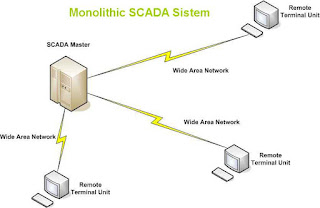At the beginning of SCADA systems used in industrial control process stated that in general computing concepts centered on the "mainframe" systems. This system does not recognize the concept of the network as a centralized system each stand alone. In other words SCADA system itself independently and there is no connectivity to other systems.
Computing technology has transformed SCADA systems are becoming more sophisticated in facing the challenges of modern control systems. Currently the SCADA system has evolved into a 3 generation as follows:
Are you curious? Let's see explanation below:
For security reasons the data traffic with RTU communications on the network connection to the master is usually carried out at the level of the bus through a proprietary adapter or controller is connected to the Central Processing Unit (CPU) backplane.
Monolithic SCADA system fitted on mainframe systems, a primary and a backup, connected on the bus to monitor the level of failure detection sensors that could potentially lead to the failure of the control system.
Connected to the network in a distributed SCADA system is generally based on proprietary LAN protocol, in which the vendor creates its own network protocol or a version thereof than attracting existing ones.
SCADA network system which is related to distributed SCADA with the main difference is the network architecture is controlled by the vendor in the exclusive neighborhood, where some of the network system serves as the master station. RTU protocol serves as a vendor-proprietary and are not able to reach beyond the limits of the local environment, but has the advantage to perform faster processing.
Networked SCADA Systems has a standard system architecture and open protocols making it possible to distribute the SCADA functions in WAN and not just the LAN. This method is able to eliminate a number of limitations on the generation of SCADA systems before.
Computing technology has transformed SCADA systems are becoming more sophisticated in facing the challenges of modern control systems. Currently the SCADA system has evolved into a 3 generation as follows:
- First Generation - Monolithic
- Second Generation - Distributed
- Third Generation - Network
Are you curious? Let's see explanation below:
1. Monolithic SCADA Sistem
In Monolithic SCADA system, Wide Area Networks (WAN) connection device to function as a remote terminal unit (RTU) that is designed with a single design system to communicate with the RTU in the field and nothing else. In addition there is a WAN protocol in the protocol used on the network developed by the SCADA RTU equipment vendors to support the process of the controlling remote device.For security reasons the data traffic with RTU communications on the network connection to the master is usually carried out at the level of the bus through a proprietary adapter or controller is connected to the Central Processing Unit (CPU) backplane.
Monolithic SCADA system fitted on mainframe systems, a primary and a backup, connected on the bus to monitor the level of failure detection sensors that could potentially lead to the failure of the control system.
 |
| Monolithic SCADA Sistem via comtechnologies.com |
2. Distributed SCADA Systems
The Distributed SCADA system has the advantage of an improvement in the system miniaturization and Local Area Network (LAN) technology to distribute processing across multiple systems. Control points at some stations will be connected to the LAN and will share information in real-time together. Miniature station is smaller and cheaper than monolithic processor scada system.Connected to the network in a distributed SCADA system is generally based on proprietary LAN protocol, in which the vendor creates its own network protocol or a version thereof than attracting existing ones.
 |
| Distributed SCADA Systems via comtechnologies.com |
3. Networked SCADA Systems
SCADA network system which is related to distributed SCADA with the main difference is the network architecture is controlled by the vendor in the exclusive neighborhood, where some of the network system serves as the master station. RTU protocol serves as a vendor-proprietary and are not able to reach beyond the limits of the local environment, but has the advantage to perform faster processing.
Networked SCADA Systems has a standard system architecture and open protocols making it possible to distribute the SCADA functions in WAN and not just the LAN. This method is able to eliminate a number of limitations on the generation of SCADA systems before.
 |
| Networked SCADA Systems via comtechnologies.com |
Conclusion
SCADA systems in modern industrial have many advantages. Such benefits could be maximized if we could use 3 types according to the needs of SCADA architecture. Another advantage brought by distribution SCADA functions above are capable of distributing processing control system at the work location physically separate, making it possible to build a SCADA system that can avoid company from the total of losses from a single location. This is also avoids the company of miscontrol totally lost in the event of production.
Labels:
SCADA Articles
SCADA Articles